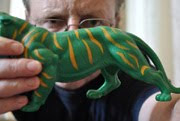Justin Sainsbury (Justin) recently asked me to contribute an Introduction to his self-published book of seaside documentary photography.
Rather than go the usual Blurb/Photobox route, Justin used a professional designer to create the layout, and has had the book printed locally in Sussex.
Typically, I left it to the last minute to produce the text, reproduced below. For an old cynic like myself it’s a bit embarrassingly “jumpers for goalposts” nostalgic, but between you and me, this reflects my genuine enthusiasm for the seaside.
Introduction
Contained within these pages is Justin Sainsbury’s photographic account of life in the seaside resorts of the English south coast.
The photos in this selection are the fruits of many hours of wandering – putting imaginary frame after imaginary frame around the world until something seems to fall into place. And then the photographer raises the camera, the camera clicks, and with skill and a little luck a good picture is the reward.
The photos here capture the simple pleasures of the seaside, deftly and realistically, without resorting to either sentimentality or cruelty. The seaside has proved to be a popular hunting ground for documentary photographers, with a wide range of outcomes. Martin Parr’s take on the resorts shown here would doubtless render them gaudy, litter strewn, run down and depressing. Other photographers (possibly myself included) might play up the idyllic nature of a gentler, nostalgic, imagined age.
It’s a delicate balance, but the spirit of Justin’s photographs reminds me of comments made about the English photographer Tony Ray-Jones, who photographed the English with enthusiasm in the 1960s
" " " " "
[His] pictures have that rare blend of humour and sadness which is born of both compassion and irony. This is something that springs from the depths of character and it is something that cannot be copied or faked. The imitation... is a blend of sentiment and sarcasm, and is totally alien to his work and to his nature
" " " " "
Ainslie Ellis, Introduction to A Day Off
Justin, born in Brighton, and a long-time inhabitant of both there and Worthing, gives us an insider’s view – the unvarnished truth. Or as near as possible as it is to display truth through the medium of photography. As well as kindly looking pensioners, there are teenagers in hoodies, art-school students, rebellious dogs, and a cast of familiar and eccentric locals carrying out their daily routines. This is a straight-ahead, honest, unpretentious version of the English seafront.
Despite regular pieces in the style magazines about how the seaside is trendy again (possibly by writers who haven’t actually visited the particular resort – I would like the see the Vogue magazine staffers braving a boisterous Friday night in Littlehampton), there are many seaside towns that are hanging on by the skins of their teeth. And a few that are doing pretty nicely. All aspects are displayed here – half-dressed fun vs the disappointment of bad weather, the Chuckle Brothers vs the local Philharmonic...
As a serial inhabitant of seaside towns myself, I enjoy the expectancy on faces and in voices when the train or coach arrives down from London – peering out of the window for a glimpse of the sea. When I visited Worthing recently in the height of summer, I was surprised to find the seafront sparsely populated, and many of the seafronts in Justin’s photos don’t seem that lively either. In bad weather the tourist’s day can resemble an endurance test to be conquered with anoraks, packed lunches and flasks of tea. More so than elsewhere, the weather can make or break the seaside experience. At seaside resorts, there are often limited opportunities for indoor leisure, and so the weather is all important. Unlike, say, London, which just looks and feels a bit nicer in good weather, Worthing can seem idyllic in fair weather, but if you chance upon it on a bad day, it can seem deathly grim. And if the fireworks are cancelled, it’s no fun at all...
Meeting up with Justin, I come to realise that he plays down the more extreme artistic pretensions of this sort of street photography, likening it more to a sport. At 6 foot 7, he was much in demand on the basketball court and it’s easy to imagine the successful shots here being like a basketball slam dunk. Street photographers rely on a variety of methods to take photos without alarming their subjects – speed and attempts at ‘invisibility’ usually are key. Given his height, Justin decided that invisibility was not a viable option, and instead he goes about his business of documenting the seafront quite openly – taking candid shots but ready to engage his subjects in conversation when spotted. His natural empathy, interest and respect for his subjects doubtless comes in handy...
Tony Ray-Jones famously said that ‘I have tried to show the sadness and humour in a gentle madness that prevails in people’, and this gentle – and some not so gentle – madness seems particularly apparent at the beach, where a sub-zero midnight swim seems like a good idea after some refreshment, and a romantic walk to the end of the pier will inevitably lead to a kiss. Justin’s photos remind us of all the natural fun and numerous tiny disappointments, again without resorting to sentimentality or cruelty.
The whole seaside experience is here, briefly in black and white, and latterly in colour. The two casts of characters – the die-hard locals and the day-trippers – a black and white café whose patron is contemplating the day ahead, looks that could kill, and the couple enjoying a tender moment on Littlehampton seafront.
Enjoy the experience!
Paul Russell
October 2007
